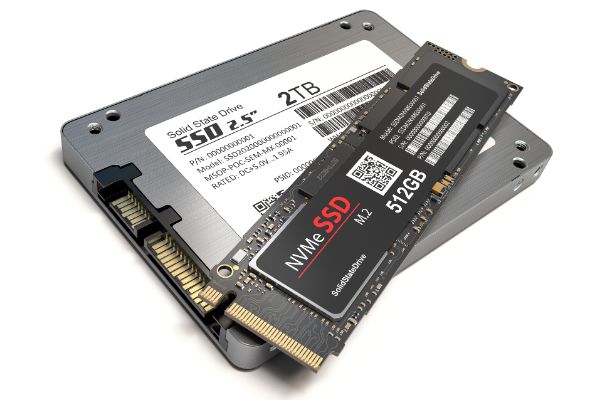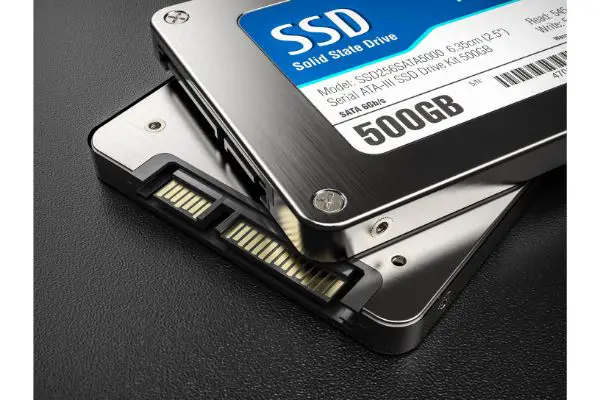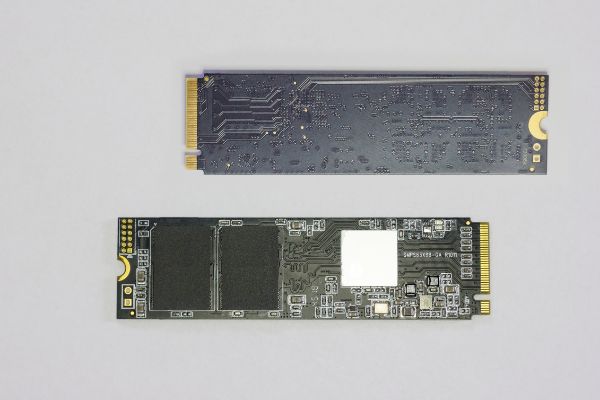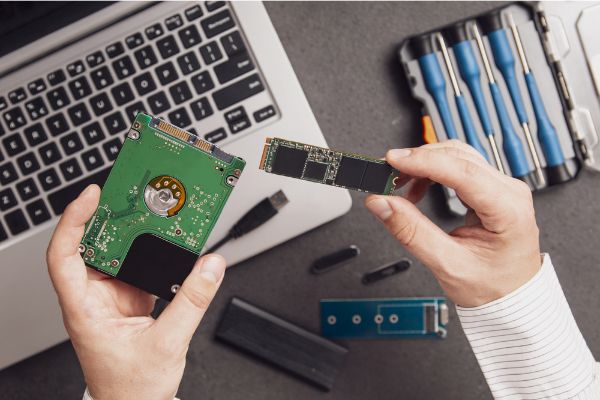Disclaimer: This post may contain affiliate links, meaning we get a small commission if you make a purchase through our links, at no cost to you. For more information, please visit our Disclaimer Page.
If you’re a hardcore PC gamer, you probably know and appreciate the difference Solid State Drives (SSDs) make when we compare them to the older Hard Disc Drives (HDDs). SSDs becoming mainstream was perhaps the best thing to happen to the gaming industry in the past decade. However, a new, even better technology seems to have surfaced– what are M.2 SSDs, and how do they work?
M.2 SSDs outperform traditional SATA-based SSDs by most performance indicating metrics, including raw data transfer speed. M.2s are technically better than SSDs for gaming, but you may see only a marginal improvement in all but the most demanding games.
If you’re looking for a more detailed answer, we’ll discuss how each of these technologies works and determine whether you should upgrade to an M.2 SSD. This article will provide you with a complete guide, so buckle up.
Table of Contents
The Fundamental Difference Between SSD and M.2
The critical thing to note about this comparison is that M.2 SSDs are a specific type of SSD. M.2 itself is simply a form factor, which refers to the physical dimensions of a piece of computer hardware.
For practical purposes, we’ll be comparing regular or traditional SSDs (2.5″ connected to the motherboard via SATA cable) with M.2 SSDs (M.2 form factor SSDs connected via the SATA or NVMe interface).
And, to be clear, there is a marked difference between the two.
What Is an SSD?
Let’s bring everyone up to speed by first looking at the humble SSD. This speedy, power efficient, and robust technology, and people often compare this system to its predecessor, the HDD. And rightfully so— the SSD makes up for nearly all of its older brother’s shortcomings.
An SSD or solid-state drive is a storage drive on your computer and works with other components such as your processor and memory systems to access and use data. The SSD replaced the HDD (hard disc drives) as they are faster, more durable, and use less power.
As most gamers will know, Hard Disc Drives are slow, have mechanical moving parts (which means they’re most at risk of being damaged by physical forces), and, quite frankly, somewhat outdated.
Hard Disc Drives don’t age well, so using one that’s seen a few years can be quite the hassle. They sometimes fail to load crucial data, and you run into nasty and confusing errors.
Don’t get us wrong; HDDs are not obsolete. Many gamers still use them in combination with a faster storage device, but they are by no means the industry standard today.
HDDs were the staple storage device until SSDs took over in the 2010s. The compact SSDs boasted no moving parts (meaning it’s less likely to be damaged and runs much quieter) and lightning-fast transfer speeds of up to 600 Mbps. That is, compared to the HDD, which typically operates at a much lower 30 to 150 Mbps.
On the surface, this difference doesn’t live up to its hype. That’s true on paper, but another factor to consider is latency. HDDs are notorious for poor latency. They must spin around until they reach the disc area where the required data is stored.
See, the data transfer rate is an essential factor for gamers. Not only does it decrease the initial loading time, but it also eliminates any lag or frame drops you might face due to data not being transferred from the storage to the running software fast enough.
Interestingly, this is one of the reasons resource-intensive games of the modern day run much better on an SSD than an HDD.
Cyberpunk 2077 is an excellent example of such a game. As confirmed by the developers, one of the reasons the game failed to run smoothly on the previous generation consoles (PS4 and Xbox One) was the painfully low data transfer rate of the installed HDDs.
The point is that SSDs are the baseline for triple-A gaming today. While an HDD can suffice with many older and simpler games, you probably will run into issues playing newer, heavier titles.
The good news is that most prebuilt gaming desktops and laptops today come with an SSD by default, so you probably have one if you’re using a recently built system.
However, many older (think before 2015) computers are fashioned only with the traditional HDD. No worries, though. SSDs are affordable and readily available—and you can install them within minutes.
Whether or not an SSD is what you want to upgrade to depends on some factors that we’re about to discuss.
How an SSD Works
An SSD uses flash memory to store data onto itself. It has no moving parts, making it more compact and power-efficient. Millions of tiny ‘cells.’ are responsible for storing your valuable data.
If you made the connection, this flash memory is the same technology used in USB and flash drives. Hence the high data transfer rates.
The SSD functions as a secondary storage device in computer architecture. It’s where all your files, data, settings, applications, and other permanent memory are stored.
Traditional SSDs are typically 2.5 inches in width (although there are some 3.5-inch SSDs, too), which means they fit perfectly into the drive bay where you would position an HDD. They are attached to the motherboard via a SATA cable.
SATA stands for Serial Advanced Technology Attachment and is a bus interface. That might be some high-level tech jargon, but essentially, it’s what transports data from the SSD to the rest of the computer and back.
The Benefits of an SSD
Let’s now discuss the benefits of an SSD in terms of gaming.
1. Fast Loading Times
This feature is where you’ll most feel the effects of faster data transfer speed. For games you store on an SSD—loading times are brief and convenient.
The reduced loading time applies to almost ALL load times you can imagine. The initial time it takes to arrive at the game menu after you decide to run it. The time it takes for in-game loading screens to leave you alone. The time it takes for a new map to load.
2. Faster Boot Time
This feature is a notable improvement—where your device takes less time to boot up, regardless of your operating system.
It also eliminates the likelihood that your device will freeze during startup, which was quite prevalent back when HDDs were the norm.
3. A Smoother Gaming Experience
“How?” you might ask. It’s true that when talking about gaming performance, it’s the CPU, GPU, and RAM that matter the most.
Storage used to be pretty low on the list of things determining how many frames per second you got. But things have changed. The biggest titles today will need you to have top-of-the-line processing speeds to run them; that’s a given.
But they also need to be fed data continuously and quickly. That’s where fast data transfer makes a big difference. Stunning graphics come at a cost—large textures.
While your game runs, these textures constantly load onto the primary memory (RAM and VRAM). If your storage device’s transfer rate can’t keep up with these demands, you end up with missing textures and game-breaking bugs.
Of course, you also get sharp frame drops and full-on stutters, which can make or break the deal in competitive games.
Thankfully, SSDs usually have more than enough data transfer speeds to feed data to the game as required.
HDDs, unfortunately, are getting left behind in the past, with texture streaming capabilities now being an essential factor when it comes to enjoying more graphically demanding games.
4. Power Efficiency
Since SSDs don’t have moving parts, they don’t need as much energy. This advantage and several other benefits make SSDs highly beneficial to laptops.
As a result of not needing much power, SSDs also don’t produce a lot of heat. Plus, they’re compact and take up much less physical space.
When you consider that even modern laptops suffer from low battery life and poor heat dissipation, SSDs seem like a godsend.
Of course, this aspect of them is beneficial for desktop computers too. It’s just not as noticeable.
What Is an M.2 SSD?
Now, onto the part you’ve been waiting for—the newer M.2 SSDs.
M.2 conventionally refers to SSDs that conform to the M.2 form factor instead of having the typical 2.5″ width.
M.2 SSDs are the next generation form factor of the traditional mSATA. They are smaller than their traditional counterparts—while providing comparable storage sizes. This feature makes for a highly dense and space-efficient secondary storage device that’s now seen commonly in laptops and tablets.
Here’s an excellent resource to determine whether a particular laptop has an M.2 slot on its motherboard.
How an M.2 SSD Works
M.2 SSDs are technologically similar to regular SSDs. They, too, use flash technology and millions of tiny “cells” to store all of your permanent data.
The primary difference lies in how an M.2 SSD is attached to the motherboard. As previously stated, 2.5-inch SSDs connect to the motherboard via a SATA cable.
M.2 SSDs, on the other hand, do not need such a cable. They can connect to the motherboard directly by plugging into an M.2 port.
The Benefits of an M.2 Over a Regular SSD
M.2 SSDs generally outperform regular SSDs because of their smaller size and ability to utilize the NVMe Interface Protocol. Here’s more detail:
1. Faster Data Transfer Rate
However, there is a caveat you need to be aware of before declaring M.2 SSDs the clear winner. If you’ve been surfing the net for info on M.2 SSDs, you’ve probably also come across the term “NVMe.”
NVMe stands for Non-Volatile Memory Express. The NVMe Interface Protocol uses the PCI Express bus and is like the SATA Interface Protocol, which is much faster in transporting data.
M.2 SSDs can operate on both protocols, but there’s a catch.
An M.2 SSD operating on the SATA protocol will give you speeds similar to a regular SSD, around 600 Mbps. So while you will benefit from the more compact size, you won’t have an advantage over the standard-sized technology. If space is your only concern, a SATA-based M.2 will serve you just fine.
If you are looking for a performance boost—you should ensure that your M.2 SSD is operating on the NVMe Interface Protocol. In other words, you’ll need an M.2 NVMe SSD, which gives you data transfer speeds up to 8 times faster than SATA-based drives.
That’s a remarkable difference. NVMe drives typically give you over 3500 Mbps of read/write speed.
So what makes M.2 SSDs faster than the SATA-based, 2.5″ standard is the NVMe protocol, which is now the standard for M.2 SSDs.
2. Smaller Size
An M.2 SSD is significantly smaller than a 2.5-inch SSD, meaning it will take up less room in your PC or laptop. The M.2 form factor is currently the most compact form factor for secondary storage devices available on the market.
The mSATA form factor previously held this record but is now much smaller than an SSD but slightly larger than an M.2.
The reduced size is especially beneficial for laptops, and we are now seeing more and more high-end laptops released with M.2 slots built into their motherboards.
Finding sufficient space for components in a laptop poses a significant design and performance constraint. However, with this system, you may dedicate any space not used up by secondary storage devices to improve other components or add new features.
3. No Need for a SATA Cable or Storage Bay
Since an M.2 SSD can fit snugly into its dedicated port, there’s no need for a SATA cable or a storage bay that you would have used to house a regular 2.5″ SSD. This option allows you to opt for a PC casing without a storage bay.
Not needing a SATA cable is also great for those who hate clutter. If you’re spending thousands on a high-end PC with beautiful RGB and design, you’ll probably want to ensure the internal wiring is as tidy as possible. Having one less cable to deal with is a bonus.
M.2 vs. SSD: The Verdict
Alright. We’ve reviewed and compared traditional SSDs and M.2 SSDs in great detail. We’ve also taken a look at some statistics. Let’s round them up for a final comparison.
- Hard Disc Drives: 30 – 150 Mbps
- Standard, 2.5″, SATA-based Solid Slate Drives: 600 Mbps
- SATA-based M.2 Drives: 600 Mbps
- NVMe-based M.2 Drives: 3500 Mbps+
Well, those are the numbers. And these numbers suggest that there’s a clear winner. Sure enough, the NVMe-based M.2 Drive is currently the leading secondary storage technology in the world.
If You’re Upgrading From an SSD
But whether or not it’s worth upgrading to one from an SSD deserves some commentary. The thing is: SSDs work just fine for the overwhelming majority of games.
Hard Disc Drives were too slow for loading and texture streaming, so we shifted to SSDs. But the situation is different this time. Regular SSDs, with their 600 Mbps transfer speed, are great at what they do.
You likely won’t see significant improvement in your gaming performance upgrading from an SSD to an NVMe M.2.
You will find your load times further reduced—but they have already been brought down to mere seconds by regular SSDs. This lack of observable difference means that your SSD should be fine unless you’re looking to “Min/Max” your setup.
Additionally, higher transfer speeds require great CPU utilization. If you don’t have a CPU that’s strong enough, you might just bottleneck on that end and not get to utilize the additional read/write speed.
Although gamers probably won’t struggle in that department. CPUs with upwards of 4 cores and 8 threads have become much more affordable with time, to the point where one can incorporate them into any budget or entry-level builds without breaking the bank.
Also worth mentioning is that much of the bonus speed NVMe M.2 SSDs offer is restricted to sequential reads and writes. This specificity means that the full force of the NVMe M.2 won’t come into play when random data from all over the drive is needed, as is typically the case during gameplay.
If You’re Upgrading From an HDD
In this case, you do have a fair choice to make.
You can go for the newer NVMe M.2, which will likely become the industry standard in the future. Doing so is considerably more expensive, as the drives themselves cost more, and you’ll get to have a motherboard that has the M.2 slot. But it’s worth it because your system will be more ‘future-proof.’
Opting for a regular SATA-based SSD isn’t out of the question either! If you’re on a budget, We recommend you go this route to spend more on components that determine performance more heavily, such as the CPU and GPU.
Outside of Gaming
Keep in mind that throughout this comparison, we kept in mind solely the interests of a gamer, which is why I consider the upgrade from 600 Mbps to 3500 Mbps an unnecessary move.
However, if you’re, say, a video editor or a 3D animator, then things are a little different. In these cases, you save a fair bit of time from having that extra transfer rate, and going for the M.2 becomes all the more beneficial.
Transferring large files is typically a sequential read/write, and you can use your industry-leading speed to its best potential.
The Bottom Line
M.2 SSDs provide the same benefits while offering a compact form and a much faster data transfer rate when operated on the NVMe Interface Protocol. However, this quicker data transfer rate does not significantly impact a gaming session. So while an upgrade will help, it’s not necessary for gamers on a budget.




